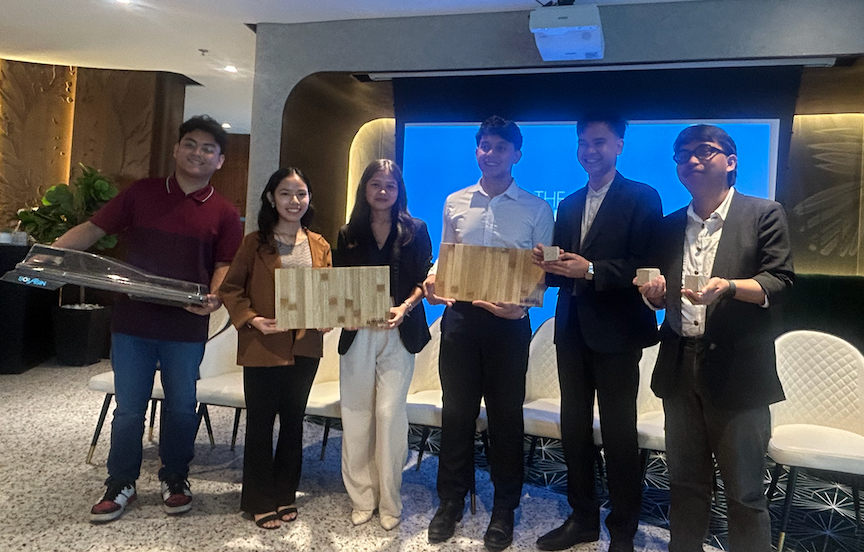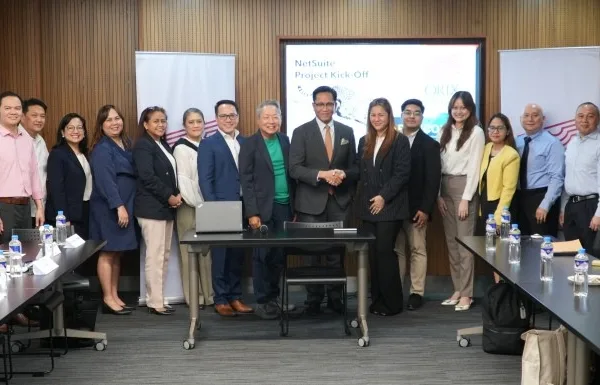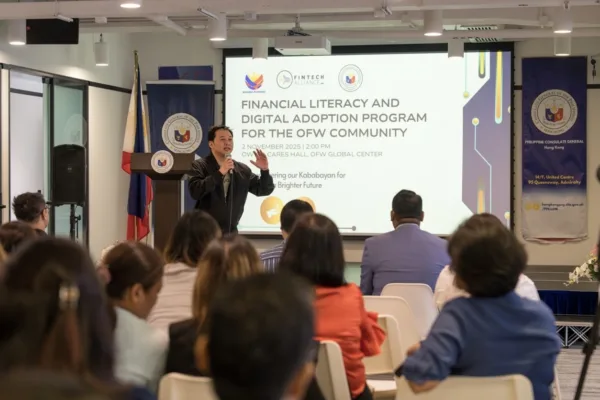A wave of homegrown innovation is taking center stage in this year’s James Dyson Award as Filipino student inventors unveil powerful, tech-enabled solutions to some of the country’s most pressing challenges — from reviving the salt industry, creating sustainable construction materials using bamboo, to cooling homes without electricity.

Photo shows John Carlo Luna Reyes (left, national round winner for SolAsin), together with finalists Jo Jane Nalam, Guendolyn Almonte, and Sandrew Rogel Eya (Lambooply) as well as John Joseph Banticil and Jayvimar Sumagang (Chillwise) after presenting their inventions
Topping the Philippines’ national round is SolAsin, a compact, solar-powered salt-farming unit designed by John Carlo Luna Reyes, an industrial design student from the University of the Philippines (UP) Diliman. SolAsin is a low-tech, high-impact invention aimed at empowering coastal communities and helping rejuvenate a struggling industry — one flake of salt at a time.
Two other student teams, both from Mindanao State University-Iligan Institute of Technology (MSU-IIT), were named national runners-up: ChillWise, an energy-free cooling panel system that uses agro-waste, and Lambooply, a sustainable construction material made from bamboo and native grass.
All three projects will move on to the international stage of the James Dyson Award, with a shot at winning the global prize of ₱2.1 million.
SolAsin: Reclaiming a lost industry with solar-powered ingenuity
Reyes’ winning entry, SolAsin, is a timely response to the near-collapse of the Philippine salt industry.

Despite the recent Salt Industry Development Law, the country still imports over 90% of its salt. Coastal communities — once thriving hubs of salt production — now face limited livelihood options due to urbanization, climate change, and disrupted coastlines.
SolAsin changes that.
Using filtered seawater and solar evaporation, the portable unit produces flaky salt, a premium variety prized by restaurants and specialty markets. Compact and cost-effective, it bypasses the need for vast salt beds and large capital investments — making it ideal for use by coastal families or micro-enterprises.
Reyes, who hails from Pangasinan (“a place where salt is made”), developed SolAsin through extensive fieldwork, prototyping, and community consultation. “As a designer and an Iskolar ng Bayan, I’ve always felt responsible for creating solutions that empower my own community,” he said.
SolAsin earned Reyes ₱361,300 in national prize money, which he plans to use for further development and local pilot programs.
Dr. Jaine Cadoc-Reyes, a James Dyson Award judge and professor at UP Los Baños, praised the project’s “simplicity, scalability, and social impact.” Dyson’s own Senior Program Manager Melvin John Dela Peña added, “SolAsin perfectly embodies Dyson’s problem-solving ethos — practical design driven by real-world needs.”
ChillWise: Cooling without electricity

Also earning recognition is ChillWise, a passive cooling panel system designed to beat the tropical heat without using energy.
The solution is elegantly low-tech: it uses foamed concrete infused with agro-waste, like rice hull ash and fly ash, to absorb heat during the day and release it at night—dramatically reducing the need for air conditioning.
Capable of lowering indoor temperatures with up to 95% less energy use compared to traditional concrete, ChillWise addresses a widespread issue: most Filipino homes and schools lack air-conditioning due to high costs and energy consumption. It offers an affordable, eco-friendly alternative, especially in low-income or off-grid areas.
Lambooply: Rethinking construction materials

The third standout finalist is Lambooply, a sustainable composite material made by reinforcing bamboo with Lampakanay (cattail grass).
Free from synthetic adhesives and engineered for strength, Lambooply offers an environmentally sound substitute for wood in both structural and decorative applications.
With the Philippines facing deforestation and a heavy reliance on imported lumber, Lambooply proposes utilizing bamboo, a locally sourced, renewable alternative that leverages abundant — but often overlooked — natural resources.
Next stop: Global stage
SolAsin, ChillWise, and Lambooply now advance to the international finals, where Dyson engineers will select a Top 20 shortlist on October 15, followed by the announcement of the global winners on November 5, personally chosen by Sir James Dyson.
For Reyes and his fellow inventors, the recognition from James Dyson Award is more than just a competition win — it’s a call to action.
“Growing up in Pangasinan, I saw firsthand how coastal communities have struggled to access
sustainable livelihood opportunities. As a designer and an Iskolar ng Bayan, I have always felt a responsibility to use my skills to empower my own community,” Reyes shared.
“I hope this inspires more young Filipino designers to look to our own communities and industries. After all, the best solutions often come from understanding our own backyard,” he added.
About the James Dyson Award
The James Dyson Award forms part of a wider commitment by Sir James Dyson to demonstrate the power of engineers to solve the world’s problems. Run by the James Dyson Foundation, the competition has supported inventions with prize money and has given the inventors a chance to gain global media exposure.
Founded in 2002, the foundation is an international education charity whose mission is to inspire the next generation of engineers. The Foundation also invests in medical research and has donated more than ₱11 billion to charitable causes to date.
Now in its 20th year, the James Dyson Award celebrates design and engineering students tackling global problems through innovation. Since its launch, it has supported over 400 inventions and awarded more than ₱70 million in prize money across 28 countries and regions.








